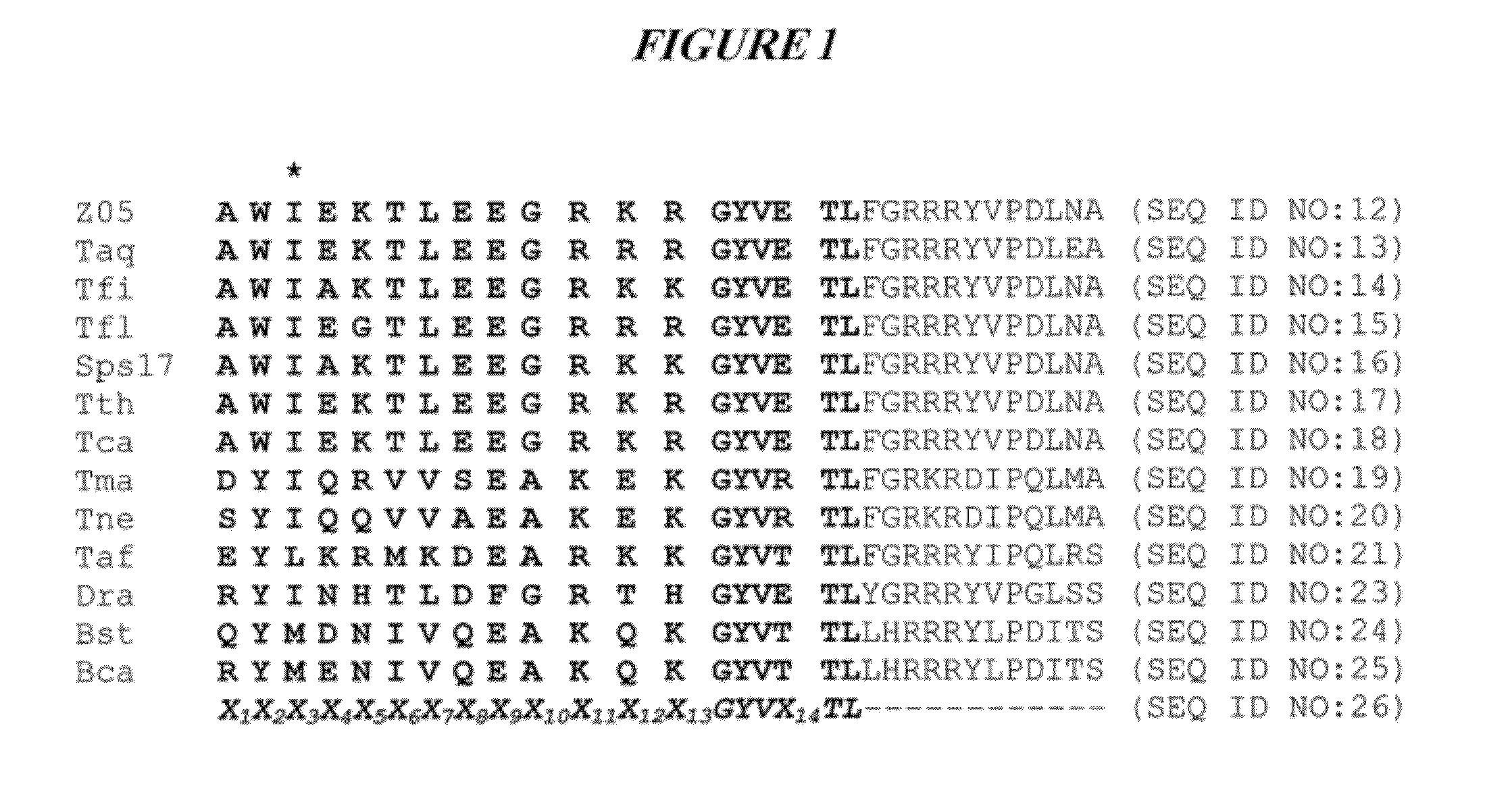DNA polymerases with improved activity
a polymerase and activity technology, applied in the field of dna polymerases with improved activity, can solve the problems of difficult detection of the presence of a target nucleic acid sequence without amplification, severe reduction of extension rate, and low overall product formation, and achieve the effect of increasing intensity
- Summary
- Abstract
- Description
- Claims
- Application Information
AI Technical Summary
Benefits of technology
Problems solved by technology
Method used
Image
Examples
example 1
Library Generation
[0217]In brief, the steps in this screening process included library generation, expression and partial purification of the mutant enzymes, screening of the enzymes for the desired properties, DNA sequencing, clonal purification, and further characterization of selected candidate mutants. Each of these steps is described further below.
[0218]Clonal Library Generation:
[0219]A nucleic acid encoding the polymerase domain of Z05 D580G DNA polymerase was subjected to error-prone (mutagenic) PCR between Blp I and Bgl II restriction sites of a plasmid including this nucleic acid sequence. The amplified sequence is provided as SEQ ID NO:39. The primers used for this are given below:
(SEQ ID NO: 30)Forward Primer: 5′-CTACCTCCTGGACCCCTCCAA-3′;and,(SEQ ID NO: 31)Reverse Primer: 5′-ATAACCAACTGGTAGTGGCGTGTAA-3′
PCR was performed using a range of Mg2+ concentrations from 1.8-3.6 mM, in order to generate libraries with a range of mutation rates. Buffer conditions were 50 mM Bicine p...
example 2
Identification of Mutant DNA Polymerases with Improved Reverse Transcription Efficiency
[0227]Screening Extract Libraries for Improved Reverse Transcription Efficiency:
[0228]The extract library was screened by comparing Cp (Crossing Point) values from growth curves generated by fluorescent 5′ nuclease (TaqMan) activity of crude enzyme extracts in a RT-PCR system from amplification of a 240 base pair amplicon from Hepatitis C Virus (HCV) transcript JP2-5, containing the first 800 bases of HCV genotype Ib 5′NTR in pSP64 poly(A) (Promega).
[0229]Reactions were carried out on the Roche LC 480 kinetic thermocycler in 384 well format with each well containing 1.5 μL of an individual enzyme extract diluted 5-fold with buffer containing 20 mM Tris-HCl, pH 8, 100 mM KCl, 0.1 mM EDTA, and 0.1% Tween-20 added to 18.5 μL of RT-PCR master mix described in Table 4. The thermocycling conditions were: 1 minute at 65° C. (“RT” step); 5 cycles of 94° C. for 15 seconds followed by 60° C. for 30 seconds;...
example 3
Screening Extract Libraries for Improved 3′ Primer Mismatch Tolerance
[0244]The extract library of Example 1 was screened for improved 3′ primer mismatch tolerance by comparing the final fluorescence after extension by an enzyme of a primer (DG48; SEQ ID NO:40, Table 10) perfectly matched to the sequence of primer M13 mp18 vs. the final fluorescence of a primer (FR744; SEQ ID NO:42; Table 10) with a 3′ A:A mismatch.
DG48 Perfect Match:(SEQ ID NO: 40)5′-GGGAAGGGCGATCGGTGCGGGCCTCTTCGC-3′FR744 A:A Mismatch:(SEQ ID NO: 42)5′-GGGAAGGGCGATCGGTGCGGGCCTCTTCGCA-3′
[0245]The enzyme extracts above were diluted 10-fold for primer extension reactions by combining 2.5 μL extract with 22.5 μl, of a buffer containing 20 mM Tris-HCl, pH 8, 100 mM KCl, 0.1 mM EDTA, and 0.2% Tween-20 in a 384-well thermocycler plate, covering and heating for 10 minutes at 90° C. Control reactions with perfect match primer combined 0.5 μL of the diluted extract with 15 μL master mix in 384-well PCR plates. Extension of th...
PUM
| Property | Measurement | Unit |
|---|---|---|
| Fraction | aaaaa | aaaaa |
| Fraction | aaaaa | aaaaa |
Abstract
Description
Claims
Application Information
 Login to View More
Login to View More - R&D
- Intellectual Property
- Life Sciences
- Materials
- Tech Scout
- Unparalleled Data Quality
- Higher Quality Content
- 60% Fewer Hallucinations
Browse by: Latest US Patents, China's latest patents, Technical Efficacy Thesaurus, Application Domain, Technology Topic, Popular Technical Reports.
© 2025 PatSnap. All rights reserved.Legal|Privacy policy|Modern Slavery Act Transparency Statement|Sitemap|About US| Contact US: help@patsnap.com



